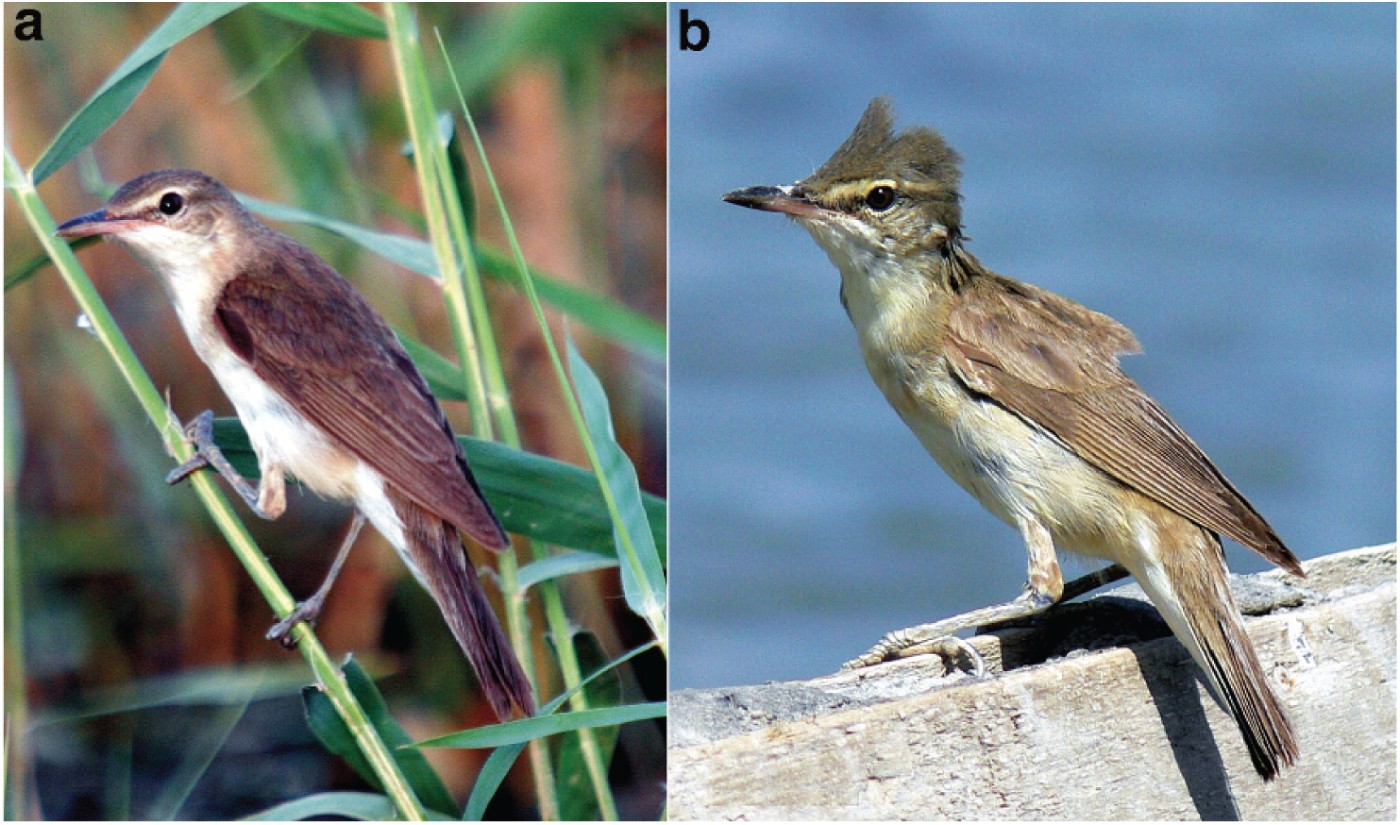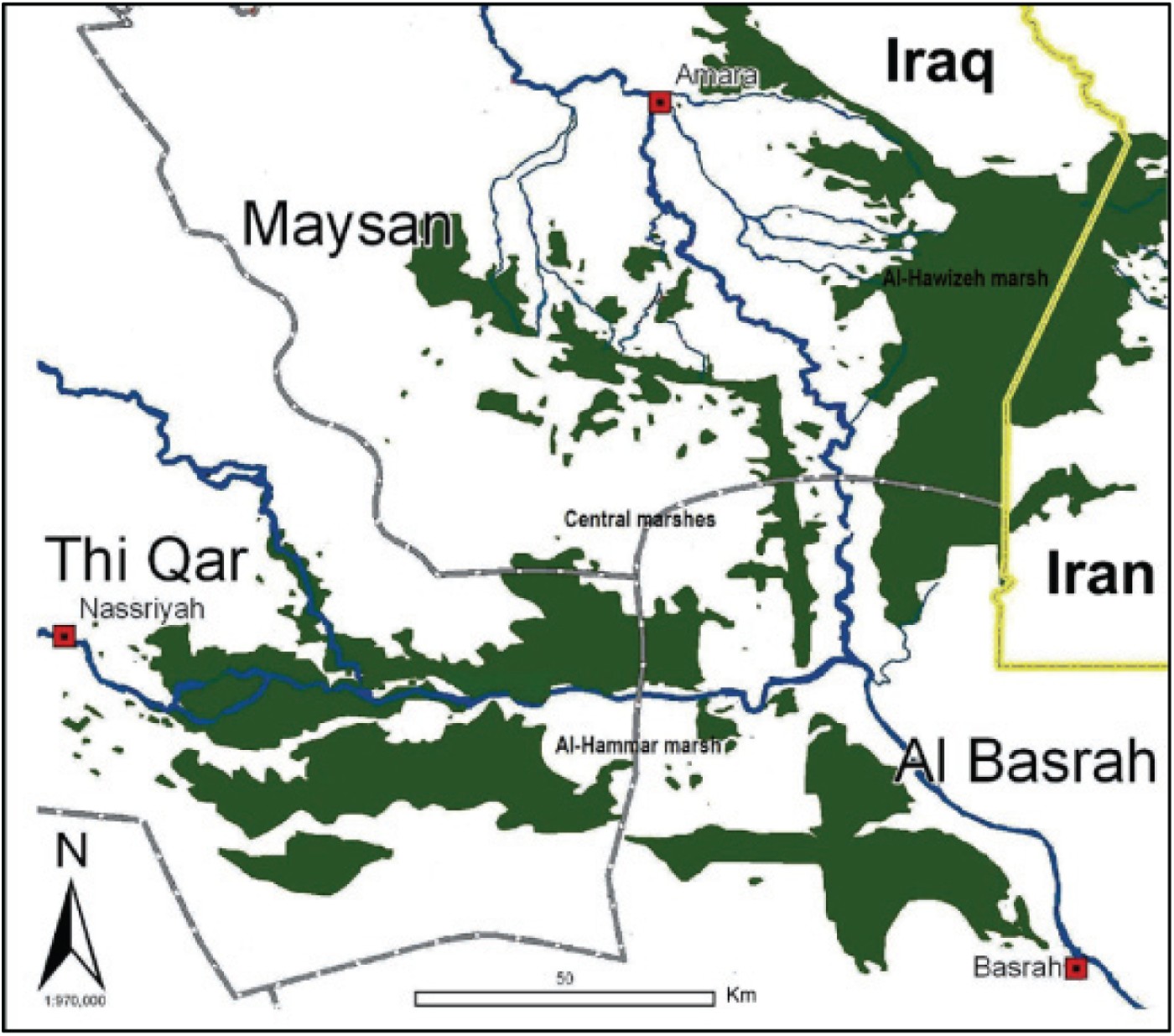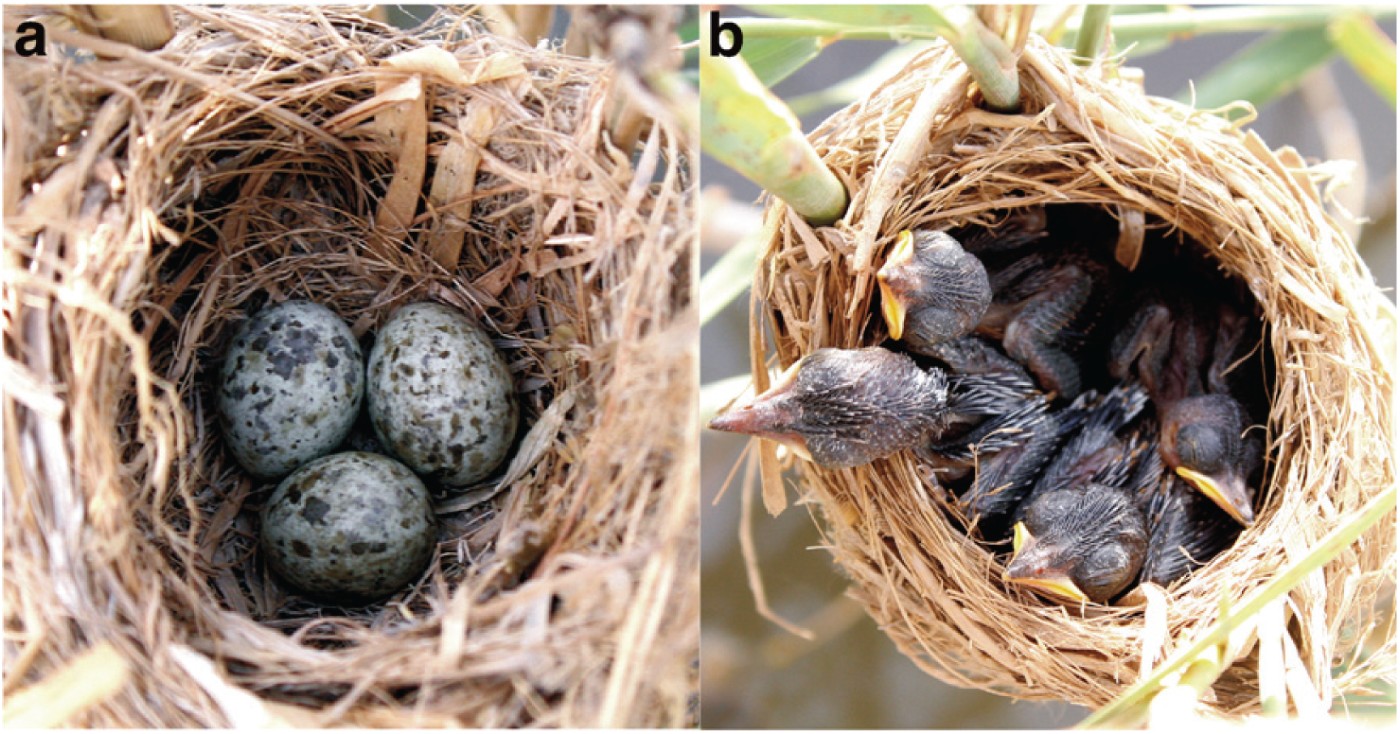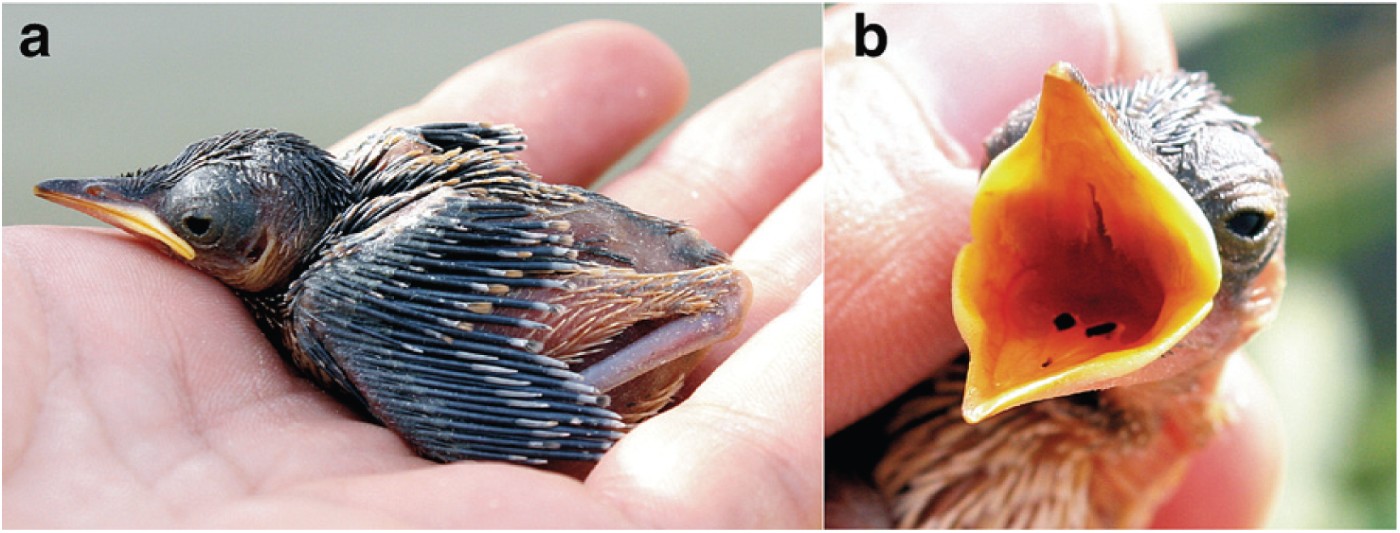Abstract
The population of the Basra Reed Warbler, Acrocephalus griseldis, which has a limited range confined to the marshlands of central and southern Iraq, has declined substantially due to massive degradation of its main breeding habitat in the Iraqi marshes during the 1980s and 1990s. The breeding habitat and breeding biology is described here. We discovered a remarkable extension of the breeding range in the extreme west of Iraq.
Introduction
The Basra Reed Warbler Acrocephalus griseldis (Hartlaub, 1891) is known as “Zarzor Al-Gissab” (Reed Sparrow) by “Marsh Arabs”, the local people of southern Iraq. It is a restricted-range species that breeds in the extensive reed beds of central and southern marshlands of Iraq (Maltby, Citation1994; Fadhel, Citation2007), and winters as a long-distance migrant in east Africa (Kennerley & Pearson, Citation2010). Recently, it was recorded breeding outside Iraq in Kuwait and Israel (Porter & Aspinall, Citation2010).
The Basra Reed Warbler was originally described as small subspecies of the Great Reed Warbler, Acrocephalus arundinaceus (Linnaeus, 1758), and has been treated as such by Allouse (Citation1953, Citation1962), Mahdi and Georg (Citation1969) and others. It was given species rank by Ticehurst (Citation1920).
The southern marshes of Iraq were known to host the largest number of breeding pairs of the Basra Reed Warbler (Evans, Citation1994; Baker, Citation1997; Kennerley & Pearson, Citation2010). The Iraq-Iran conflict (1980-1988) resulted in extensive damage to reed beds in the Mesopotamian marshes (Maltby, Citation1994). There were three main major marshes in southern Iraq, divided from each other by the Euphrates and Tigris Rivers and covering an area of 20,000 km² (). By 1993, large-scale hydrological engineering works in the Mesopotamian marshes prevented water from entering up to two-thirds of the area, with huge expanses of lake drying up (Evans, Citation1993; Pearce, Citation1993). Up to 1997, perhaps as much as one third of the original extent of suitable habitat remained on the Iraq-Iran border (Al-Hawizeh marsh), where the dominant water supply to the area (unmanaged rivers from Iran) had not yet been controlled or reduced (Maltby, Citation1994). Hence, the only remaining wetland was the northern portion of the Al-Hawizeh marsh. For instance, in 2000, the Al-Hawizeh marsh was only 35% of its 1977 size (3,076 km²: Richardson & Hussain, Citation2006). Furthermore, the Al-Hammar and Central marshes were virtually destroyed by 2000. Overall, the main Mesopotamian marshes had been initially reduced to just 1,294 km², and, by 2003 a further third of this area had been drained, thus leaving a maximum of 759 km² of extant wetland (UNEP Citation2003).
The Basra Reed Warbler is listed as Endangered by IUCN (Citation2012) due to the largescale degradation of 70%-80% of its breeding habitat in the Iraqi marshes. Scott and Evans (Citation1993) concluded that the drainage of the wetlands in lower Mesopotamia would almost certainly result in the global extinction of many species, with catastrophic consequences also for the world population of the Basra Reed Warbler. For instance, the decline of migrant Basra Reed Warblers has been noticed at the ringing station of Ngulia (Kenya). The average ringing total for this species has been decreasing over the last three decades compared to the average decadal total for all Palaearctic passerine migrants (approximately 20% per decade) (Pearson, in litt. 2003). The very low numbers of migrant birds recorded in Kenya reflect the remarkable rate of destruction of the Mesopotamian marshes (Pearson, in litt. 2003).
In 2003 the Iraqi government launched a master project for restoring the marshes of the country. By late 2006, 40% of the original marshes had been inundated (Richardson & Hussain, Citation2006). Between 2005 and 2012, the Canada-Iraq Marshlands Initiative, Nature Iraq, the Italian Ministry of Environment, Land and Seas, the Iraqi Ministry of Higher Education and Scientific Research, and the Iraqi Ministry of Environment undertook an intensive monitoring programme to survey the wildlife of the southern marshlands. The Basra Reed Warbler, a flagship and endemic species for the Iraqi marshes, was chosen as the focal taxon as it plays an important role as a bioindicator for measuring the recovery of the aquatic ecosystem.
Materials and Methods
Study area
We investigated the entire breeding habitat of the Basra Reed Warbler, which is mainly restricted to the southern Iraqi marshes and the lower Tigris and Euphrates basins. These sites include (): (1) Al-Hammar marsh, which is located south of the Euphrates River and west of its confluence with the Tigris River (Basra province); (2) Central marshes, which are located north of the Euphrates River and west of the Tigris River (ThiQar province); (3) AlHawizeh marsh, which lies east of the Tigris River and extends up to the border with Iran (Myssan province); (4) Middle Euphrates wetlands, which have a patchy distribution between the courses of the Euphrates and eastern Tigris rivers (Wasit, Qadissiya, Babel and Muthana provinces); (5) Shatt Al-Arab and Fao marshlands, which extend from the Tigris and Euphrates junction in Garmatt Ali (Basra province) to the coastline in the extreme south of Iraq (Rass Al-Besha of Fao). Three more areas situated along the Tigris and Euphrates Rivers in central and western Iraq were also covered by the fieldwork.
Field surveys
The fieldwork was conducted over four months (April to July) in 2006 and 2007 (60 days total, 15 days/month). However, the great majority of bird and nest counts were carried out in 2007. In 2011 and 2012, additional field notes were obtained from short visits and interviews with Marsh Arabs. Thick aquatic vegetation, reed beds, embankments, dry areas, and canoes were used as fixed/mobile observation sites, and also wading and hiding allowed field investigation to take place. Overall, we found 971 nests, and measurements (length, internal diameter at the upper opening) were taken using a subset of 30 nests in 2006-2012. We also measured a subset of eggs (n = 20) (length and width) obtained from 15 nests located in Al-Hammar, Central and Al-Hawizeh marshes during 2006-2012.
Sound recording
Sounds were recorded using a Marantz PMD660 recorder equipped with a Sennheiser ME67 microphone provided by the British Broadcasting Corporation (BBC). Sound records were used later by the BBC for a radio programme about the marshes of southern Iraq. Direct observation, combined with examination of high resolution pictures and sound records of the species which were compared with several field guides (Baker, Citation1997; Kennerley & Pearson, Citation2010; Porter & Aspinall, Citation2010), were used to support bird identification.
Results
Breeding habitat
The Basra Reed Warbler is mostly found in aquatic vegetation or around still/flowing shallow fresh/brackish water. The species typically inhabits large and dense reed beds (Phragmites australis) growing alongside ditches, rivers and waterways, and breeds in the aquatic vegetation including mostly Typha sp. and reed beds, although it forages extensively also in adjacent thickets. Juveniles can be often observed feeding in Typha along the dry edge of the marshes and also in adjacent Tamarix sp. scrub. During the breeding season, adults usually feed on the prominent surfaces of submerged vegetation Potamegaton sp., and on the dry flat ground near Marsh Arab settlements. However, in 2005–2006 and after the re-flooding of the Iraqi marshes, the Basra Reed Warbler was observed breeding in pure Typha cover only. The Typha cover was indeed the dominant vegetation in the re-inundated saline marshes: the reed and other aquatic vegetation was absent during the first stages of the ecological succession. After 2007 the Basra Reed Warbler was observed nesting in both Phragmites and Typha vegetation.
Behaviour
The Basra Reed Warbler is a secretive and solitary bird that can hardly be observed in the wild. It is a territorial species and a couple may occupy several breeding areas. The Basra Reed Warbler hops and leaps silently among stems, exposing itself to view very briefly. Males are very active and loud in the breeding grounds. Males usually sing low down in dense reed beds and only occasionally hop up reed stems for short periods before dropping back into the thick cover. Their song is rather loud but lower than that of the Great Reed Warbler, and seems coarser than that of the Eurasian Reed Warbler, Acrocephalus arundinaceus. Unpaired Basra Reed Warbler males were heard singing mainly in early morning and at sunset, and songs ceased during daytime and when the females were attracted. Typical hesitant chrk-chri-chrk-churrik calls can be heard between the second half of April and June. In particular, songs heard on the same note in late April and early May indicate that males are searching for additional mates.
Males are often polygynous (42.9%, n = 317 observed males). Males usually occupy territories as large as approximately 1,500–2,000 m² (possibly wider in reed beds with reduced visibility) so that they can practise deception by moving and attracting a second female, which does not realize that the male has already mated (). Males usually reach the breeding grounds in southern Iraq 7–10 days before females. These latter are more cautious than males and rarely sneak, sidle and hop on reed stems flanking the male singing site (). Courtship behaviour is very hard to observe. Nevertheless, we were lucky enough to spot breeding pair courtship on exposed reed stems in open cover in the Al-Hawizeh marsh in 2006. We observed the male bending its head, raising its crown feathers, frequently erecting and fanning its tail towards the female, and producing a distinctive subdued chrr-chrr-chrr.
Figure 2 (a) Adult male Basra Reed Warbler foraging at Haur Al-Chebaeish on 20 June 2007. (b) Adult female on 1 August 2006 (Central marshes).

Mating usually occurs silently in the lower parts of the dense reed bed stems. Nest building was observed to occur in mid-May (2006) and in late April (2007, 2012). Females are responsible for nest building while males guard them. Females carry nesting material and frequently enter/exit the nest site while the male quietly hops on the stems around the nest site. When the adults are disturbed, they fly low and protected by the vegetation away from the nesting site. The flight is manoeuvering, fast and erratic, and produces a blundering flight pattern. Adults usually return to the nest within 10–20 minutes after the disturbance has ceased.
The nest
The nest has a conical shape and hangs on a pair or trio of Typha or reed stems (only two nests built on four Typha stems were observed, in 2006), and its yellowish colour contrasts with the surrounding green cover. Usually, the nest is built 50–120 cm above the water level. The internal diameter at the upper opening of the cone was (range) 6.1–6.8 cm (6.37±0.21, N=30), while the length was 7.5-8.7 cm (8.07±0.39). The nests were mostly built up with dry reed and Typha leaves, stems, reed flowers, dry grasses and Tamarix twigs. Some nests contained feathers of water birds, and even a tuft of dark hair belonging to Water Buffalo (Bubalus bubalis) was found. Furthermore, 57% of the examined nests contained the dry moulted skin of the Dice Snake Natrix tessellata (Laurenti, 1768). The skin of this snake is usually employed by Basra Reed Warblers to reinforce the nest of reed stems so that shocks caused by heavy water waves, wind or Marsh Arabs' canoes can be effectively resisted. In 2006–2007 we observed that the great majority of the nests woven with the skin of a snake had fledgling young. This did not come as a surprise, as violent water waves can bend the stems with the nest and cause the eggs to fall into the water.
Breeding
The Basra Reed Warbler has one brood per season. Eggs are laid in the first and second decade of May. The clutch size is usually 2-4 eggs. Eggs are sub-elliptical, smooth and glossy, pale-blue or blue-green, spotted and blotched dark brown, olive green, and pale-blue grey. The average length of eggs (N=20) ranged between 1.70 and 1.80 cm (1.73± 0.04), and the width between 1.40 and 1.50 cm (1.44± 0.05) (). The incubation of the eggs usually lasted 12-15 days and was performed by the female only, while both parents fed young in the nest for a further two weeks.
The newly hatched young have a fleshy dark grey colour around the eyes and around the wing joints where the flying feathers will appear. The young have a rather long, triangular, pink to dark-grey culmen bill with a pale yellow swollen edge at its base. The lining of the mouth varies from pale to rich yellow, which becomes bright orange in the adults (, ). The tongue spots are prominent in young birds (). As soon as they have fledged, Basra Reed Warbler young are guarded by adults in the nest area for another period of 14-15 days. The breeding grounds in southern Iraq are totally vacated by late August. Spring migrant males arrive at the breeding grounds in early/mid-April. Migrant birds disperse on date palm trees, fruit orchids, tamarisk, Typha and thick reed beds along the Tigris and Euphrates Rivers in central and western Iraq.
Sympatric Acrocephalus species
Al-Hammar, Central and Al-Hawizeh marshes represent the main breeding habitat of Basra, Great, Eurasian, and Glamorous Reed Warbler Acrocephalus stentoreus brunnescens (Jerdon, 1839), a group of reed-dwelling species that require rather similar breeding habitats. Indeed, the breeding territories of these species do overlap in the three marshes mentioned above. Basra Reed Warbler dominates the majority of the breeding territory of southern Iraq rather than other Acrocephalidae species. For the Great Reed Warbler, a total of 15 birds with 11 nests was recorded in 2006–2007. For the Eurasian Reed Warbler, a total of 17 was recorded, but no nest located; however, the breeding of this species was proven for the first time in Iraq at Haur Az Zichri on 21 July, 2007 (). The status of the Glamorous Reed Warbler is uncertain. Indeed, only a few winter records from the southern marshes were obtained, although breeding behaviour was noticed on 22 June, 2007, when two adults were observed foraging in Tamarix scrubs at the edge of Al-Tena area in Al-Hammar marsh (). One of the warblers was observed carrying food and flying towards the dense reed beds, thus suggesting that it was feeding young.
Table 1. Basra Reed Warbler dataset per each surveyed area of suitable habitat. Legends: Year, year of the survey; T.c., total count of adults and juveniles; T.n., total nests; O.n., occupied nest (i.e., recently constructed, guarded or visited by adults); N.e., nest with incubated egg (s); N.c., nest with recently hatched chicks or fledgling young; U.n.: unused or abandoned nest
Breeding population
Between 2006 and 2012, we investigated 40 breeding sites (). In the southern marshes we surveyed 37 sites distributed as follows: nine in the Al-Hammar marsh, 12 in the Central marshes, six in the Al-Hawizeh marshes, six in the Middle Euphrates and eastern Tigris wetlands, four in Shatt Al-Arab and Fao marshes. An additional three sites in central and western Iraq were also surveyed (). The estimated breeding population of the Basra Reed Warbler in the Al-Hammar marsh is (370-400 pairs); Central marshes (850–900 pairs); Al-Hawizeh marshes (650–700 pairs); Middle Euphrates and eastern Tigris wetlands (60–100 pairs) (2006–2007 only); Shatt Al-Arab and Fao marshlands (10–20 pairs) (2006–2007 only). In central Iraq, Basra Reed Warblers were observed (2012) in Al-Jadriyah and Umm Al-Khanazeer Island of Baghdad. In the province of Anbar (western Iraq), Basra Reed Warblers were probably breeding (1–2 pairs) in the Hawijat Albu-Dheab marshes (northwest of Ramadi, 2009). Finally, in 2010, Basra Reed Warblers were also spotted at Anah and Rawa wetlands (extreme western Iraq).
Feeding
The Basra Reed Warbler usually feeds in dense reed beds on a variety of items including vegetation and both aquatic and terrestrial invertebrates. Aquatic insects (dragonflies, mayfly nymphs, and aquatic Hemiptera) represent the main food in the breeding grounds in southern Iraq. However, Basra Reed Warblers also predate silverfish (Thysanura), termites, grasshoppers, other insect larvae, spiders, and small earthworms. The Basra Reed Warbler can also feed on small pieces of dead fish, bread, vegetables and fruit remains littered by Marsh Arabs. Overall, the feeding behaviour is similar to that of both Great and Eurasian Reed Warbler, yet it is less apparent. However, in late-May, when most of the breeding pairs have fledged young, adults become very tame and social. Finally, the Basra Reed Warbler can take its prey from the air by flycatches.
Discussion
There is a paucity of information concerning the Basra Reed Warbler in the breeding grounds of Iraq. In this study, we shed more light on its breeding behaviour and ecology in this area. The drainage of the southern Iraqi marshes, which resulted in the catastrophic destruction of the Basra Reed Warbler breeding habitat, took place together with a marked decline in the species' global population. Between 2003 and 2006, 40% of the Iraqi marshes were inundated, thus providing suitable wetland habitats. Overall, our observations between 2006 and 2012 show that the Basra Reed Warbler was still thriving in suitable aquatic habitats, yet the species was mainly restricted to the three major marshes of southern Iraq (Al-Hammar, Central and Hawizeh, see ). Nevertheless, we discovered a remarkable extension of the known breeding range of the Basra Reed Warbler at Hawijat Albu-Dheab and Ana'a and Rawa marshes in western Iraq (). However, because of its restricted range, the survival of the Basra Reed Warbler breeding population is strictly connected to the inundation of the southern marshes which occurred in 2006. In both summer 2011 and 2012, a worrying reduction in the water level of the southern marshlands took place, especially in the Central and Al-Hawizeh marshes. The water level of the Tigris River was distinctly reduced due to dams and embankments constructed upstream in Turkey. In addition, Tigris tributaries deriving from the Iranian side were blocked and/or re-directed, thus markedly influencing the water level in the wetlands of eastern Iraq (particularly in the Al-Hawizeh marsh). Overall, compared to the breeding population assessed before, in 2011 we recorded a noticeable decline of Basra Reed Warbler nesting pairs due to the destruction of the species' habitat caused mainly by dams and water management activities upstream of the Tigris River basin. Regrettably, in 2011 and 2012, severe drought brought an additional threat to the survival of the population. Furthermore, energy production and oil mining by contracting companies had a negative impact on many areas of southern Iraq, especially in the Al-Hawizeh and Shatt Al-Arab marshlands.
There are serious concerns that the gradual worsening of the Iraqi marshlands will result in a marked decline in the survival of many species. Therefore, serious conservation actions should be undertaken soon. The Iraqi government is responsible for the protection of the Basra Reed Warbler as it represents one of the iconic species of concern in the country. An international cooperation between Iraq and the countries sharing water resources should be undertaken as soon as possible in order to conserve the biota of the marshlands. The Basra Reed Warbler population and its unique habitat in central and southern Iraq need to be urgently included in a long-term monitoring programme, and a national action plan dedicated to the Basra Reed Warbler should be prioritized to protect and conserve the species in Iraq.
Acknowledgements
We would like to thank the Canada-Iraq Marshland Initiative (CIMI), the University of WaterlooOntario (Canada), and the Italian Ministry of Environment, Land and Seas (IMELS) for their support for the mission to restore the Iraqi marshlands. We are grateful to Nature Iraq, the Iraqi Ministry of Higher Education and Scientific Research, and the Iraqi Ministry of Environment (IMoE) for their support of the fieldwork. We are grateful to the British Broadcasting Corporation (BBC) for supplying the sound recording equipment. Our thanks extend to Ali N. Salman, Mohammad Fadhil (IMoE), Richard Porter, Sharif Al-Jabor, Dr Mukhtar K. Haba, and Dr Jamal K. Al-Abayachi for their support during the fieldwork; Dr Suzie Alwash, for her assistance in preparing the initial draft of this manuscript; Keith Holmes, University of Victoria (Canada), for providing the GIS map of the southern Iraqi marshes; David Pearson, for his advice and comments on warbler studies in Iraq. Finally, we are deeply grateful to all the reviewers who greatly improved a first version of this manuscript.
Notes
A Statement relating to this debate can be found at http://dx/doi/10.1080/09397140.2016.1172405
References
- Allouse , B. 1953 . The avifauna of Iraq . Iraq Natural History Museum Publication , 3 : 1 – 163 .
- Allouse , B. 1962 . Birds of Iraq , Vol. III , Baghdad : Al-Rabita Press . in Arabic
- Baker , K. 1997 . Warblers of Europe, Asia and North Africa , Princeton : Princeton University Press .
- Evans , M. I. 1993 . Iraq marshes doomed . Ornithological Society of the Middle East, Bulletin , 31 : 28 – 29 .
- Evans , M. I. 1994 . Important Bird Areas in the Middle East , Edited by: Evans , M. I. BirdLife Conservation Expedition of the International Waterfowl Research Bureau and the University of Basrah .
- Fadhel , O. 2007 . Days in Iraq with the Basra Reed Warbler Acrocephalus griseldis . Sandgrouse , 29 : 95 – 97 .
- IUCN . 2012 . IUCN Red List of Threatened Species (ver. 2012.1) www.iucnredlist.org [Accessed 15 June 2012]
- Kennerley , P. and Pearson , D. 2010 . Reed and Bush Warblers , London : Christopher Helm & Black .
- Mahdi , N. and Georg , P. V. 1969 . A systematic list of the vertebrates of Iraq . Iraq Natural History Museum Publication , 26 : 1 – 104 .
- Maltby , E. 1994 . An environmental and ecological study of the marshlands of Mesopotamia , London : AMAR Appeal Trust .
- Pearce , F. 1993 . Draining life from Iraq's marshes . New Scientist , 138 : 11 – 12 .
- Porter , R. F. and Aspinall , S. 2010 . Birds of the Middle East , London : Poyser .
- Richardson , C. J. and Hussain , N. A. 2006 . Restoring the Garden of Eden: An ecological assessment of the marshes of Iraq . BioScience , 56 : 477 – 489 . (doi:10.1641/0006-3568(2006)56[477:RTGOEA]2.0.CO;2)
- Scott , D.A. and Evans , M. I. 1993 . Wildlife of the Mesopotamian Marshlands , 146 University of Exeter: Wetlands Ecosystem Research Group, Report .
- Ticehurst , C. B. 1920 . A new species of Reed Warbler from the marshes of Lower Mesopotamia Acrocephalus babylonicus . Bulletin of the British Ornithologists Club , 41 : 12 – 13 .
- UNEP (United Nations Environment Programme) . 2003 . Environment in Iraq , UNEP Progress Report .


